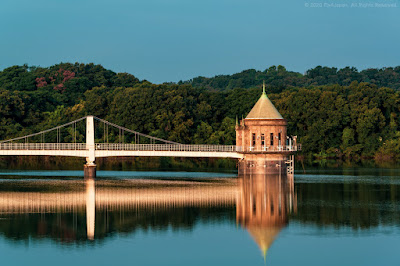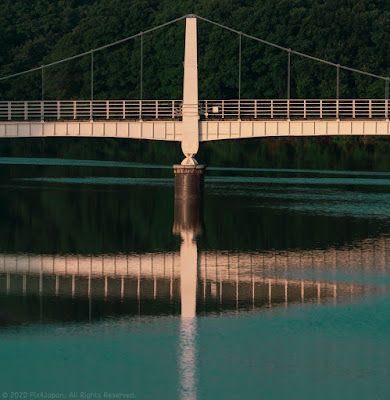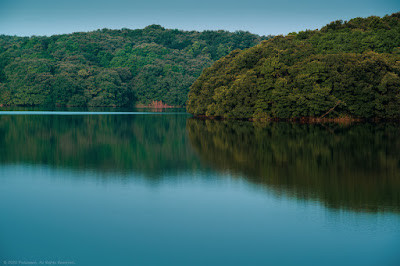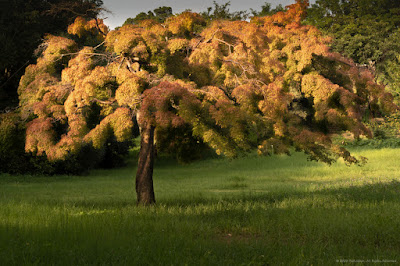Sayama Lake, originally called Yamaguchi Lake, is a man-made reservoir that was built using an earthen dam, which was completed in 1929. Due to a lack of heavy earth-moving equipment in Japan at that time, the dam was constructed mostly by farmers who used picks and shovels. The majority of the workers were farmers hired to do the work after the growing season had come to a close. A total of 1,720 villagers were forced to leave their homes to make way for the dam as demand for fresh water increased with a population explosion in Tokyo.
During WWII, the embankment of the dam was reinforced with ballistic-resistant concrete and the towers were reinforced with a bullet-proof exterior as measures against the Tokyo air raids.
The design of the intake towers was heavily influenced by the trends of western architecture that were poplar in Japan in the early 20th century, as can be seen by the use of red bricks on the exterior, copper roofing, and artistic design elements above the doorway to the tower's interior. Although the bridge is currently painted white, early color photos from many decades ago show a bridge painted in a copper-red coat of paint, which makes it look like a miniature version of the Golden Gate Bridge in San Francisco.
On the occasion that the reservoir is partially drained for maintenance work on the water intake towers, remnants of the villages that were submerged can still be seen.
Sayama Lake is located about 40 km (approx. 25 miles) northwest of Tokyo. It takes about 2 hours to drive there if you avoid toll roads. Luckily, the lake is easily accessible by public transportation as well. Links for access are posted at the end of this post.
My dog and I left home at around 1:00 a.m. and reached a parking lot right across the street from the lake about 90 minutes before sunrise. Across the street from the parking lot is the entrance to the park grounds that are located on the eastern side of the lake where the earthen dam is located.
Since the reservoir is used to provide fresh water to the residents of Tokyo, the lake itself is off limits to any human activity in the water: no swimming, no boating, no fishing, etc. The hills surrounding the lake are also off limits. Except for the promenade running across the top of the dam, high fencing with several bands of barbwire encircle the rest of the hills that feed water into the lake. The lack of human access has created a small oasis of natural habitat where various species of insects, birds, mammals and flora can flourish.
Unsurprisingly, the sky and horizon were hazy during this photo shoot, as tends to be the case during summer. On clear days from autumn to spring, however (or soon after a typhoon), bird watchers and photographers can be seen on top of the dam trying to catch shots or views of various birds. During the dryer months of winter, Mt. Fuji can be seen from the dam along with its reflection on the lake water under the right conditions.
While scouting for compositions, I met many elderly people who had come out for an early morning walk, and several folks who were walking their dogs. My border collie was well behaved and didn't raise a ruckus with the other dogs. She got along well with the owners as well. I enjoyed chatting with the kind folks who visited the dam from local neighborhoods.
For this particular photo shoot, my primary aim was to capture shots of the water intake towers and the cable-stayed bridges that lead out into the water about 20 to 30 meters from the shoreline. Of the 21 shots I took, only four were good enough to publish on social media. And maybe 2 shots will be added to my portfolio. I find it incredibly difficult to objectively select a photo that might be considered a good photograph. I would love to know how other photographers "grade" or evaluate their own photos, and at what point can they honestly say that such-and-such a shot is indeed a good photograph.
I clearly have photos that I like more than others, but I am obviously biased.
Water Intake Tower and Bridge
Pentax KP 98 mm ISO 100 for 1/25 sec. at ƒ/13
#Japan #reservoir #lake #park #freshwater #greenery #sunrise #tower #WaterIntake #scenic #landscape #summer #NaturePreserve
#狭山湖 #山口湖 #所沢市 #埼玉県 #取水塔 #西洋の雰囲気 #水道水
Portfolio: https://pix4japan.myportfolio.com
After the sun had finally rose above the horizon, the golden light lit up the water intake tower and bridge creating a beautiful reflection on the water surface. The lack of strong wind helped to ensure that the reflection was mostly smooth.
Cable-Stayed Bridge of Water Reservoir
Pentax KP 190 mm ISO 100 for 1/80 sec. at ƒ/9
#Japan #reservoir #lake #bridge #cablestayed #greenery #sunrise #reflections #scenic #landscape #summer #goldenhour
#狭山湖 #山口湖 #所沢市 #埼玉県 #斜張橋 #吊り橋 #水道水
Portfolio: https://pix4japan.myportfolio.com
This shot was taken in vertical mode, but I had too much dead space at the bottom. I cropped the image to make it easier to post online at various social media sites. I feel the color of the bridge appears a bit overexposed. I still lack the technical skills to raise the exposure of the water and forested hills without blowing out the white paint. This particular shot was a compromise between these two conflicting desires. I wonder if it is apparent to the casual viewer, but I was drawn drawn into this composition not because of the bridge, but rather because of the zigzag reflections that are not exactly symmetrical with the bridge. It is almost like an optical illusion to my eyes.
Wooded Hills and Freshwater Reservoir
Pentax KP 135 mm ISO 100 for 1/60 sec. at ƒ/10
#Japan #reservoir #woodland #forest #lake #shoreline #freshwater #lush #scenic #landscape #summer #goldenhour
#木 #森 #狭山湖 #森林地 #湖畔 #貯水池 #所沢市 #埼玉県
Portfolio: https://pix4japan.myportfolio.com
This is my second favorite shot after the photo of the water intake tower. The composition is very simple with very little change in the basic colors throughout the scene. That said, I like the minimalism of this shot--very simple and uncomplicated. My eye is especially drawn to the symmetry of the lush hills and their reflections, and to the slight change in hues of green between the foliage in the middleground and that of the background.
Japanese Maple Tree in Park
Pentax KP 55 mm ISO 100 for 1/60 sec. at ƒ/10
#Japan #tree #maple #leaves #park #greenery #foliage #lush #scenic #landscape #summer #goldenhour
#もみじ #木 #狭山湖 #六道山公園 #所沢市 #埼玉県
Portfolio: https://pix4japan.myportfolio.com
Just before leaving to go home, we walked to the far end of the dam and followed some foot trails through some nice, grassy areas of the park that is part of the dam. As I turned a corner around a huge cedar tree, this Japanese maple tree with leaves that were distinctly different from the lush, dark green foliage that surrounded the park came into my view. The morning sun cast soft, golden light on the leaves highlighting the contrast in colors with all of the other trees in the park.
Since all the photos in this shoot were shot in RAW format, some post-processing was required to bring out the tones, light, and mood that were present at the time I took the photos.
Check out the vlog post for this photo shoot on YouTube:
Access by car:
- Google Maps link to nearest parking lot: https://goo.gl/maps/VSvzNaFfpEuufiJc8
- Lake Sayama #2 Parking Lot (狭山湖第二駐車場)
- Address: 1370 Kamiyamaguchi, Tokorozawa, Saitama 359-1153
- Japanese address: 〒359-1153 埼玉県所沢市大字上山口1370
Access by train:
- Google Maps link to nearest train station: https://goo.gl/maps/YKc3EBLuBGvRVmz9A
- Seibukyujo-Mae Station (西武球場前駅) on the Seibu-Sayama Line which is accessible from Nishi-Tokorozawa Station on the Seibu-Ikebukuro Line.
Here is the list of gear I used for this photo shoot:
- Photography Gear:
- Pentax KP Body and Lens Kit (https://amzn.to/2EbbLRZ)
- Standard zoom lens:
- smc Pentax-DA 18-135mm F3.5-5.6 ED AL[IF] DC WR (https://amzn.to/2Ysz5lJ)
- Telephoto zoom lens:
- HD Pentax-DA 55-300mm F4.5-6.3 ED PLM WR RE (https://amzn.to/3iNEsDF)
- Tripod:
- Manfrotto MT190CXPRO4 (carbon fiber legs with quick locking clamps) (https://amzn.to/2Fqpghd)
- Ball head:
- Manfrotto Cloud XPRO Series Ballhead BHQ2 with 200PL locking plate (https://amzn.to/3g6WI9j)
- Video Gear:
- Mirrorless Camera:
- Canon EOS Kiss M/M50 Double Zoom Kit (https://amzn.to/2Ef3mNg)
- Prime lens:
- SIGMA 16mm F1.4 DC DN | Contemporary C017 (Canon EF-M Mount, APS-C Size, Mirrorless Only) (https://amzn.to/3axkn1w)
*Links to Amazon are affiliated links, which means that if you choose to purchase an item that I may get a small commission that has no bearing on your purchase price whatsoever.
A
Pix4Japan by Iketani, Daisei is licensed under a
Creative Commons Attribution-NonCommercial-ShareAlike 4.0 International License.
Permissions beyond the scope of this license are available at Caubarrere Piché LLC.

Pix4Japan by Iketani, Daisei is licensed under a
Creative Commons Attribution-NonCommercial-ShareAlike 4.0 International License.
Permissions beyond the scope of this license are available at Caubarrere Piché LLC.




No comments:
Post a Comment